This article was published in Scientific American’s former blog network and reflects the views of the author, not necessarily those of Scientific American
Editor's note: There’s a fascinating natural experiment happening around Ascension Island. While the number of fish here is astounding, surprisingly few species have been hardy enough and lucky enough to make the long journey and settle here successfully. Now a team of scientific divers has taken the rare and brief opportunity to come to this rock in the middle of the Atlantic Ocean and study one of the most poorly understood marine communities in the world—to try to figure out where these fish come from, how long they’ve been here, and how they’re making a living in such isolation.
“Let the games begin,” Luiz Rocha says, as we each heft 40-plus pounds of gear onto our shoulders and begin the long trudge over volcanic boulders and through deep sand, zig-zagging around enormous craters left by nesting sea turtles during their latest bout of egg-laying.
Rocha, a curator of ichthyology at the California Academy of Sciences, and his Brazilian collaborators, Sergio Floeter and Carlos Ferreira, have waited 20 years for this moment. Although they have all studied Ascension Island from afar and have published several papers about this 88-square-kilometer volcanic rock’s place in Atlantic Ocean biogeography, they’ve never actually set foot on its shores. Now, for the first time, they’re about to plunge into the clear, blue water of Ascension’s English Bay to witness this elegant natural experiment for themselves.
On supporting science journalism
If you're enjoying this article, consider supporting our award-winning journalism by subscribing. By purchasing a subscription you are helping to ensure the future of impactful stories about the discoveries and ideas shaping our world today.
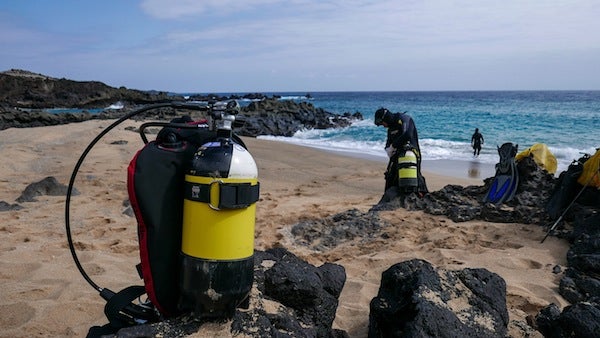
The team prepares for a beach-entry shore dive on the north coast of Ascension. (Photo by Steven Bedard)
On this, their first day in the field, the team of four, including the enthusiastic and hard-working Renato Morais, a recent Master’s student of Floeter’s at the Federal University of Santa Catarina, are armed only with cameras (not to mention several decades’ worth of experience studying reef organisms in the Atlantic). On subsequent dives, they’ll swap the cameras for spears, nets, tape measures and an array of GoPros that they’ll anchor to the bottom at strategic locations. With only 12 days here, they know they’ll need to work quickly to collect as much data as possible. No one knows when or if they’ll be able to return to this strange and remote place, so they’re determined to learn as much as they can while they’re here.
Ascension Island sits perched atop the mid-Atlantic Ridge, nearly equidistant from West Africa on one side and Brazil on the other. Ascension’s sister island and closest point of comparison, both geographically and biologically, is Saint Helena. At a distance of nearly 750 miles (1,200 kilometers), it’s the closest landmass in any direction. There are other islands and archipelagos in the Atlantic, but they’re all farther away and none sits as far out to sea as Ascension.
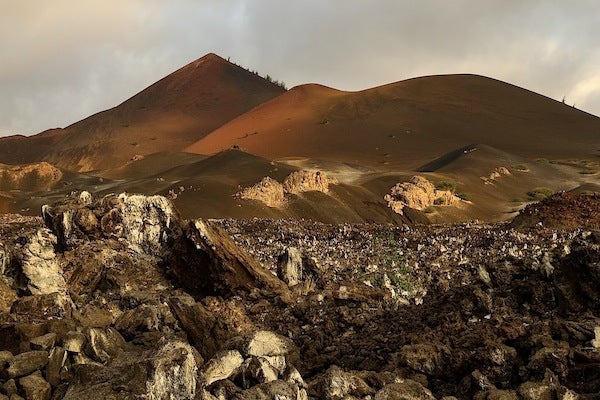
The cinder cones and basalt flows that dot the landscape here are a constant reminder of the island’s volcanic origins. (Photo by Steven Bedard)
That isolation and the island’s relatively young age of 1.15 million years—by far the youngest of the tropical Atlantic islands—have painted a peculiar biological and ecological picture. To start, this is a tremendously challenging place for most species to reach. While large-bodied pelagic fish, like tuna and sharks, are able to make the trip as adults, most reef fishes rely on hardy larvae, friendly currents and a boatload of luck to cross the thousand or so miles of deep ocean from some distant coast before they can even hope to settle into suitable habitat here.
The odds are so poor, it’s astonishing any have managed to make the journey, but dozens have—nearly an equal number of species from the west as from the east, including reefs as far away as the Indian Ocean. At present, the number of successful colonizers sits at 108. Of these, 11 species are endemic, which means they’re found nowhere else on Earth—it also means they’ve been here long enough to have evolved and differentiated from the original gene pools from which they came.
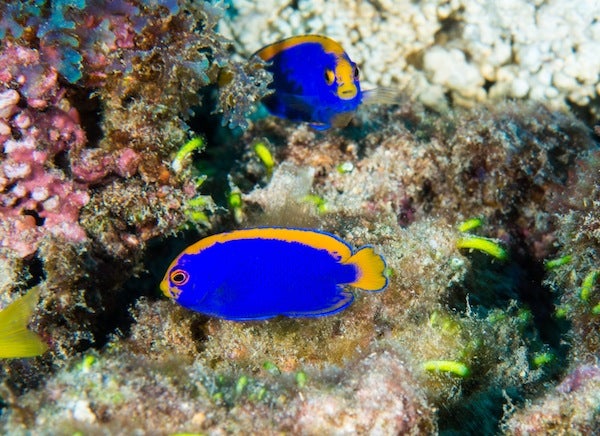
The resplendent angelfish (Centropyge resplendens), one of Ascension’s 11 endemic species and a fish highly sought by the aquarium trade. (Photo by Luiz Rocha)
Although Ascension has seen a fair number of these successful colonizations, the diversity here remains remarkably low. To put this into perspective, the island has about one-tenth the number of fish species you’d find within any similar-sized stretch of reef in the Coral Triangle of the Indo-Pacific. Only two other islands in the tropical Atlantic have fewer coastal fish species than Ascension.
Still, as low as the diversity here is, the sheer number of fish is anything but. The nutrient-rich waters around Ascension support a staggering abundance of bodies. On this very first dive, we encounter breathtaking schools of just some of the species that have made it here: surgeonfish and jacks, squirrelfish and sergeant-majors, and one of Ascension’s best known species, the black triggerfish. At times, we’re absolutely surrounded by heavy, disk-shaped creatures, each one at least the size of a salad plate, many much larger than that. Rocha estimates that the density of fish here is 100 times what he saw during a recent trip to Bermuda. “It’s hard to even get a good picture,” he says of his efforts to capture individual portraits of Ascension’s endemics. “There’s always someone photo-bombing your shot.”
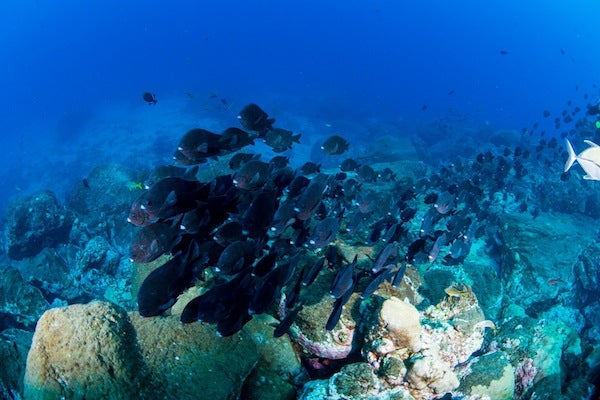
A school of sergeant-majors (Abudefduf saxatilis) on a mission as they mob-feed through the reef. (Photo by Luiz Rocha)
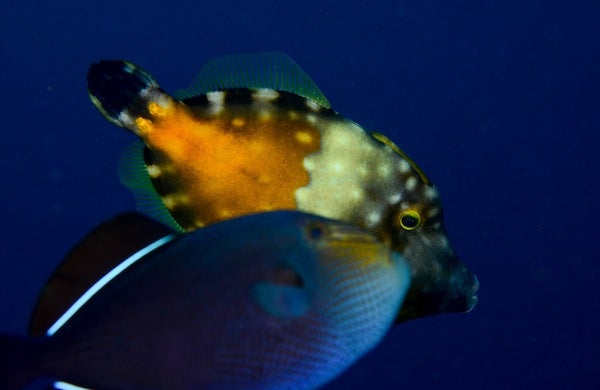
A black triggerfish (Melichthys niger) photobombs Luiz Rocha’s portrait of a whitespotted filefish (Cantherhines macrocerus). (Photo by Luiz Rocha)
While many of the species here are found elsewhere, the scientists suspect the fish have likely found a wealth of open niches around Ascension—foods, breeding habitats and hiding places that would have been filled by any number of other species where they evolved. There might simply be an abundance of opportunity here, particularly for generalists or fish capable of a greater degree of plasticity in terms of behavior and food choices. The fact is, no one really knows. Aside from the basic list of ingredients—the age of the island, its location, size and the number of species that have managed to colonize the place—no one knows much about Ascension Island’s marine ecosystem. Where many of these fish came from, how long they’ve been here, and exactly how they’re making a living in this remote place is a mystery. That’s why these scientists have waited so long to come to Ascension, and why they’re so happy to be here now.
Over the next couple of weeks, we’ll be watching as they examine the rich and strange marine community of Ascension Island. Next we’ll take a closer look at one of the island’s most iconic species, the black triggerfish, to try to better understand how it’s managed to become so wildly successful way out here above the mid-Atlantic ridge.
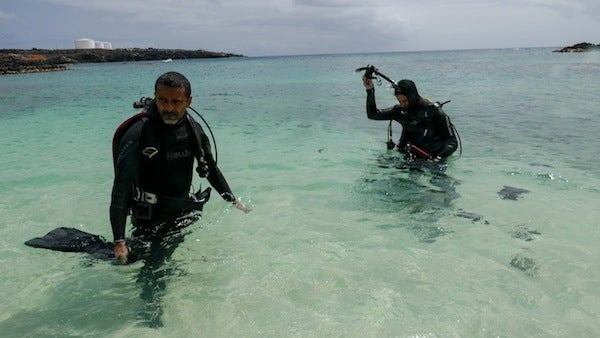
Luiz Rocha (left) and Sergio Floeter celebrate their first dive at Ascension and look forward to many more over the next 11 days. (Photo by Steven Bedard)